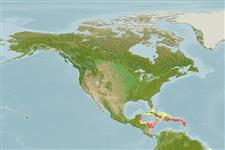>
Blenniiformes (Blennies) >
Chaenopsidae (Pike-, tube- and flagblennies)
Etymology: Emblemariopsis: Latin, emblema = insertion, inlaid work, raised ornament + Greek, opsis = appearance (Ref. 45335).
Environment: milieu / climate zone / depth range / distribution range
Οικολογία
Θαλασσινό(ά) Υφαλόφιλο(α); εύρος βάθους 1 - 8 m (Ref. 125603). Tropical
Κατανομή
Χώρες | Περιοχές FAO | Οικοσυστήματα | Παρουσίες | Point map | Εισαγωγές | Faunafri
Western Central Atlantic: Belize, Honduras, south to Panama; on the islands of the western Caribbean, including San Andres and Cayman Islands; across to the northern Antilles: Mona Island, Puerto Rico, and St. Croix, St. Barthélemy, and Isla Aves, but stopping before Dominica. Apparently absent from the southern Caribbean east of Panama, i.e. Colombia, Aruba, Bonaire, Curaçao, Venezuela, Trinidad, and the Windward (southern) Lesser Antilles (Dominica, Martinique, St. Lucia, Barbados, St. Vincent and Grenadines, Grenada, and Tobago); to the north, absent from the Gulf of Mexico, Florida, the Bahamas.
Μέγεθος / Βάρος / Age
Maturity: Lm ? range ? - ? cm
Max length : 2.0 cm SL αρσενικό/απροσδιόριστο; (Ref. 51458)
Short description
Μορφολογία | Μορφομετρία
Ραχιαίες άκανθες (συνολικά): 19 - 21; Μαλακές ραχιαίες ακτίνες (συνολικά): 10-13; Εδρικές άκανθες 2; Μαλακές εδρικές ακτίνες: 19 - 21. This species with an orbital cirrus and no red banner is distinguished by the following characters: TP territorial males found in holes with a black head; the anterior dorsal fin black, with a short, thin, white margin reaching back to second membrane; the first two membranes well incised; first dorsal-fin spine relatively short, when adpressed reaching to about 5th-6th spine base, about 1/2 HL, the third and fourth spines are also shorter, subsequent spines rising to midfin spines (Ref. 125603).
Dark-shaded and transitional TP with a relatively short first dorsal-fin spine, the second spine usually equal, with third spine about 2/3 of first, the fourth spine less than 1/2 first spine, and tenth spine about equal to first, profile of anterior dorsal fin with a moderate concavity, decreasing during transition; the first three dorsal-fin membranes white tipped, tips rounded and membranes incised; usually distinct large head spots; a prominent characteristic black spot a third way along the lower lip; without dense speckling of dorsal-fin and pectoral-fin membranes; row of dark spots along lateral midline adsent, no rows of dark spots along proximal spinous-dorsal-fin membranes, and no opercular bands or lines (Ref. 125603).
IP with elongated first two dorsal-fin spines, the first spine when adpressed reaching to base of 5th-8th spine base, the second spine about equal, the third about 2/3 of first, first two membranes with white rounded tips. Colouration: live colors greenish blue and gold; the cranial pattern of bluish spots and reticulations with a greenish gold background; IP head spots are usually reduced; melanophores near pectoral-fin base with a short oblique band to none (Ref. 125603)
Life cycle and mating behavior
Γεννητική Ωρίμανση | Αναπαραγωγή | Γεννοβολία | Αβγά | Γονιμότητα | Προνύμφες
Victor, B.C., 2020. Review of the glass blennies (Teleostei: Chaenopsidae: Emblemariopsis) with two new species from the Caribbean Sea. J. Ocean Sci. Foundation 37:1-122. (Ref. 125603)
IUCN Red List Status (Ref. 130435)
Threat to humans
Harmless
Human uses
Περισσότερες πληροφορίες
ΧώρεςΠεριοχές FAOΟικοσυστήματαΠαρουσίεςΕισαγωγέςStocksΟικολογίαΔίαιταΤροφικά αντικείμεναΚατανάλωση τροφήςΣιτηρέσιο
Κοινά ονόματαΣυνώνυμαΜεταβολισμόςΘηρευτέςΟικοτοξικολογίαΑναπαραγωγήΓεννητική ΩρίμανσηΓεννοβολίαΣυναθροίσεις γεννοβολίαςΓονιμότηταΑβγάEgg development
Age/SizeΑύξησηLength-weightLength-lengthLength-frequenciesΜορφομετρίαΜορφολογίαΠρονύμφεςΔυναμική προνυμφώνΣτρατολόγησηΑφθονίαBRUVS
ΑναφορέςΥδατοκαλλιέργειεςΠροφίλ υδατοκαλλιέργειαςΣτελέχοιΓενετικήElectrophoresesΚληρονομικότηταΑσθένειεςΜεταποίησηNutrientsMass conversion
ΣυνεργάτεςΦωτογραφίεςStamps, Coins Misc.ΉχοιΣιγκουατέραΤαχύτηταΚολυμβητικός ΤύποςΕπιφάνεια βραγχίωνOtolithsΕγκέφαλοιΌραση
Εργαλεία
Special reports
Download XML
Διαδικτυακές πηγές
Estimates based on models
Preferred temperature (Ref.
123201): 27.3 - 28.2, mean 27.8 °C (based on 156 cells).
Phylogenetic diversity index (Ref.
82804): PD
50 = 0.5001 [Uniqueness, from 0.5 = low to 2.0 = high].
Bayesian length-weight: a=0.00457 (0.00183 - 0.01143), b=3.08 (2.86 - 3.30), in cm total length, based on LWR estimates for this (Sub)family-body shape (Ref.
93245).
Τροφικό Επίπεδο (Ref.
69278): 3.1 ±0.4 se; based on size and trophs of closest relatives
Fishing Vulnerability (Ref.
59153): Low vulnerability (10 of 100).
